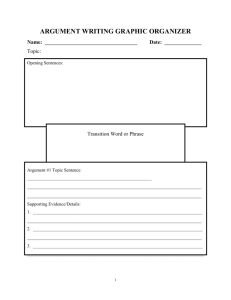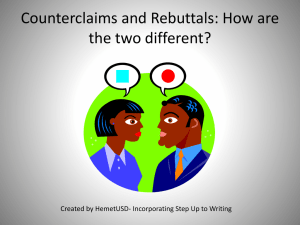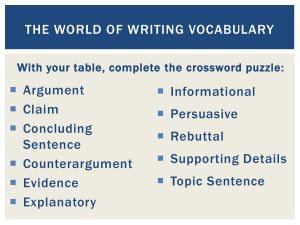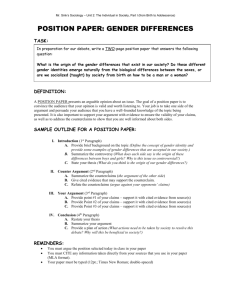Argumentative Essay Rubric
advertisement
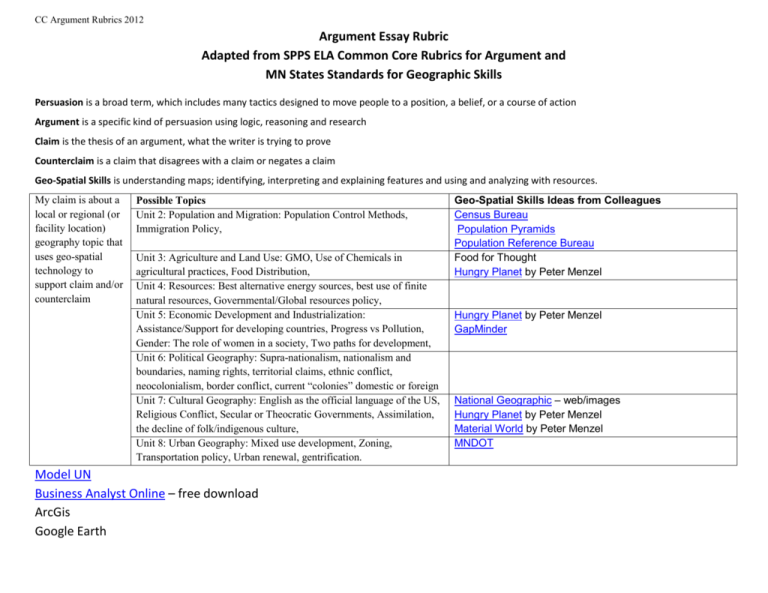
CC Argument Rubrics 2012 Argument Essay Rubric Adapted from SPPS ELA Common Core Rubrics for Argument and MN States Standards for Geographic Skills Persuasion is a broad term, which includes many tactics designed to move people to a position, a belief, or a course of action Argument is a specific kind of persuasion using logic, reasoning and research Claim is the thesis of an argument, what the writer is trying to prove Counterclaim is a claim that disagrees with a claim or negates a claim Geo-Spatial Skills is understanding maps; identifying, interpreting and explaining features and using and analyzing with resources. My claim is about a local or regional (or facility location) geography topic that uses geo-spatial technology to support claim and/or counterclaim Possible Topics Unit 2: Population and Migration: Population Control Methods, Immigration Policy, Unit 3: Agriculture and Land Use: GMO, Use of Chemicals in agricultural practices, Food Distribution, Unit 4: Resources: Best alternative energy sources, best use of finite natural resources, Governmental/Global resources policy, Unit 5: Economic Development and Industrialization: Assistance/Support for developing countries, Progress vs Pollution, Gender: The role of women in a society, Two paths for development, Unit 6: Political Geography: Supra-nationalism, nationalism and boundaries, naming rights, territorial claims, ethnic conflict, neocolonialism, border conflict, current “colonies” domestic or foreign Unit 7: Cultural Geography: English as the official language of the US, Religious Conflict, Secular or Theocratic Governments, Assimilation, the decline of folk/indigenous culture, Unit 8: Urban Geography: Mixed use development, Zoning, Transportation policy, Urban renewal, gentrification. Model UN Business Analyst Online – free download ArcGis Google Earth Geo-Spatial Skills Ideas from Colleagues Census Bureau Population Pyramids Population Reference Bureau Food for Thought Hungry Planet by Peter Menzel Hungry Planet by Peter Menzel GapMinder National Geographic – web/images Hungry Planet by Peter Menzel Material World by Peter Menzel MNDOT 12th Government 10th Human Geography 8th Global Studies Common Core 6.14.1.1 Write arguments focused on discipline-specific content a. Introduce claim(s) about a topic or issue, acknowledge and distinguish the claim(s) from alternate or opposing claims, and organize the reasons and evidence logically. b. Support claim(s) with logical reasoning and relevant, accurate data and credible evidence that demonstrate an understanding of the topic or text, using credible sources c. Use words, phrases and clauses to create cohesion and clarify the relationship among claim(s), counterclaims, reasons and evidence d. Establish and maintain a formal style e. Provide a concluding statement or section that follows from and supports the argument presented 9.14.1.1 Write arguments focused on discipline-specific content a. Introduce precise claim(s), distinguish the claim(s) from alternate or opposing claims, and create an organization that established clear relationships among the claim(s), counterclaims, reasons and evidence b. Develop claim(s) and counterclaims fairly, supplying data and credible evidence for each while pointing out the strengths and limitations of both claim(s) and counterclaims in a disciplineappropriate form and in a manner that anticipated the audience’s knowledge level and concerns. c. Use words, phrases and clauses to create cohesion and clarify the relationship among claim(s), counterclaims, reasons and evidence d. Establish and maintain a formal style e. Provide a concluding statement or section that follows from and supports the argument presented 11.14.1.1 Write argument focused on discipline-specific content a. Introduce precise, knowledgeable claim(s), establish the significance of the claim(s), distinguish the claim(s) form alternate or opposing claims b. Develop claim(s) and counterclaims fairly and thoroughly, supplying the most relevant data and credible evidence for each while pointing out the strengths and limitations of both claim(s) and counter claims in the a discipline-appropriate form that anticipates the audience’s knowledge level, concerns, values, and possible biases. c. Use words, phrases and clauses to create cohesion and clarify the relationship among claim(s), counterclaims, reasons and evidence d. Establish and maintain a formal style e. Provide a concluding statement or section that follows from and supports the argument presented Social Studies Standard 8.4.1.2.1 Formulate questions about topics in geography; pose possible answers; use geospatial technology to analyze problems and make decisions within a spatial context. 9.4.1.2.1 Use geospatial technologies to make and justify decisions about the best location for facilities or 9.4.1.2.2 Use geospatial technologies to develop plans for analyzing and solving local and regional problems that have spatial dimensions 9.1.1.1.4 Examine a public policy issue by defining the problem, developing alternative courses of action, evaluating the consequences of each alternative, selecting a course of action, and designing a plan to implement the action and resolve the problem 8TH GLOBAL STUDIES SPPS Argument Rubrics: ELL, Model UN, Global Studies, Human Geography, Government December 2012 CC Argument Rubrics 2012 Category a. Claims Introduction a. Reason and Evidence Organization b. Claim Support e. Conclusion d. Formal Style GeoSpatial Skills 4 – Exceeding Standard My introduction about a topic in geography includes a claim clearly distinguishable from a counterclaim. My reasons are linked to supporting evidence and organized in a logical manner. My claims are supported with logical reasoning and relevant evidence from accurate, credible sources (including geo-spatial technology) to demonstrate my understanding of the topic. My conclusion strengthens the overall claim(s) and key reasons and closes my product effectively, by making distinctions from counterclaim(s). I can communicate clearly and thoroughly to the target audience using third person, facts, and relative context. My claim is about a geographic problem that is addressed thoroughly using geo-spatial technology. 3 – Meets Standard 2 – Approaching Standard 1 – Below Standard My introduction about a topic in geography introduces a claim and counterclaim. My introduction about a topic in geography included claims and counterclaims that are not distinguishable from each other. My reasons and evidence are not organized or logical. My introduction about a topic in geography does not include claims and counterclaims. My reasons and evidence are disorganized. No evidence My claims are supported with logical reasoning and relevant evidence from credible sources to demonstrate my understanding of the topic. My claims are supported by some reasoning and evidence. I have reasons, but no evidence to support my claims. No evidence My conclusion restates the overall claim(s) and key reasons and closes my product effectively. My conclusion restates the overall claim(s). I included a conclusion, but it is an ineffective conclusion. No evidence I can communicate to the target audience using third person, facts, and relative context. My claim is about a geographic problem that is addressed using geo-spatial technology. I keep target audience in mind but include opinion in addition to facts. I used slang, first person, and/or opinion. I did not keep my target audience in mind. My claim is not about a geographic problem and/or does not use geo-spatial technology. No evidence My reasons and evidence are organized and logical. My claim is about a geographic problem, but is not addressed using geospatial technology. ELL Geography Level 3 Rubric – Developed by LEAP and Rebecca Biel 0 – Far from Meeting Standard No evidence No evidence 4 – Exceeding Standard 3 – Meets Standard 2 – Approaching Standard 1 – Below Standard a. Claims Introduction My introduction about a topic in geography includes a claim clearly distinguishable from a counterclaim. My introduction about a topic in geography introduces a claim and counterclaim. My introduction about a topic in geography does not include claims and counterclaims. a. Reason and Evidence Organization b. Claim Support My reasons are linked to supporting evidence and organized in a logical manner. My reasons and evidence are organized and logical. My introduction about a topic in geography included claims and counterclaims that are not distinguishable from each other. My reasons and evidence are not organized or logical. My reasons and evidence are disorganized. No evidence My claims are supported with logical reasoning and relevant evidence from accurate, credible sources (including geo-spatial technology) to demonstrate my understanding of the topic. My words, phrases and clauses create connections and clarify the relationship among claim(s), counterclaims, reasons and evidence. My conclusion strengthens the overall claim(s) and key reasons and closes my product effectively, by making distinctions from counterclaim(s). I can communicate clearly and thoroughly to the target audience using third person, facts, and relative context. My claim is about a geographic problem that is addressed thoroughly using geo-spatial technology. My claims are supported with logical reasoning and relevant evidence from credible sources to demonstrate my understanding of the topic. My claims are supported by some reasoning and evidence. I have reasons, but no evidence to support my claims. No evidence My words, phrases and clauses have some connections and clarify the relationship among claim(s), counterclaims, reasons and evidence. My conclusion restates the overall claim(s) and key reasons and closes my product effectively. My words, phrases and clauses have weak connections between claim(s), counterclaims, reasons and evidence. My words, phrases and clauses have no connections between claim(s), counterclaims, reasons and evidence. No evidence My conclusion restates the overall claim(s). I included a conclusion, but it is an ineffective conclusion. No evidence I can communicate to the target audience using third person, facts, and relative context. My claim is about a geographic problem that is addressed using geo-spatial technology. I keep target audience in mind but include opinion in addition to facts. I used slang, first person, and/or opinion. I did not keep my target audience in mind. No evidence My claim is about a geographic problem, but is not addressed using geospatial technology. My claim is not about a geographic problem and/or does not use geo-spatial technology. No evidence Category c. Words and Phrases that create Connections and Clarity e. Conclusion d. Formal Style GeoSpatial Skills MODEL UN RUBRIC, DEVELOPED FROM UNA-MN RECOMMENDED RUBRIC, GLOBAL CLASSROOMS CURRICULUM SPPS Argument Rubrics: ELL, Model UN, Global Studies, Human Geography, Government December 2012 0 – Far from Meeting Standard No evidence CC Argument Rubrics 2012 4 Exceeds Standards 3 Meets Standards I have an in-depth description of a problem and many examples of past action taken. My country’s position is a precise claim that is well developed and distinguished from a counterclaim I have a moderate description of problem and several examples of past action. My country’s position is a claim distinguished from a counterclaim My claim is well justified through the use of reasons, evidence and relevant context from credible sources. Organization My claim, counterclaim, reasons and evidence are skillfully organized to enhance and reinforce my country’s position. My claim is justified through the use of reason, evidence and relevant context from credible sources. My claim, counterclaim, reasons and evidence are organized are organized to support my country’s position. I have provided a logical summary that reinforces my country’s position. Background Country’s Position (Claim) Justification of Position (Claim) I have provided a Summary (Conclusion) compelling, logical and eloquently stated summary that reinforces my country’s position. I have Mechanics * Precise rich language * Variety of sentences * No spelling errors * No grammatical and punctuation errors 2 Approaching Standards I have a small description of the problem and few examples of past action. My country’s position is a vague claim that is partly distinguished from a counterclaim. The position is contrary to the country’s political beliefs My claim is state and an attempt is made to justify, but the justifications given are unclear. My claim, counterclaim, reasons and evidence are partially organized to support my country’s position. I have provided a somewhat logical conclusion that supports my country’s position. 1 Below Standards 0 Far from Meeting Standards I am either missing a No examples of action description of the problem when action has taken or an example of action place and no description of taken. the problem. My country’s position is No discussion of country’s an unclear claim that needs position in the form of a elaboration. Counterclaim claim. is not included. My claim and counterclaim’s strength’s and limitations are listed with no supporting details. My claim, counterclaim, reasons and evidence are somewhat disorganized. I have provided a loosely connected conclusion for my country’s position. My claim and counterclaim’s strengths and weaknesses are not present. My claim, counterclaim, reasons and evidence are unorganized. I do not have a summary. I have a few errors, but they do not impede understanding for the audience. I have several errors, I have many errors that which may cause some make it difficult for the confusion for the audience. audience to understand. I have so many errors; my audience cannot understand my paper. 3 Meets Standards 2 Approaching 0 Far from Meeting 10TH HUMAN GEOGRAPHY 4 Exceeds Standards 1 Below Standards a. Claim Introduction Geographic Topic b. Organization My introduction includes an effective and precise claim that is clearly distinguished from counterclaim. I introduce an adequate claim that is distinguished from counterclaim. My claim, counterclaim, reasons and evidence are skillfully organized to enhance and reinforce my argument. b. Claim Development I fully evaluate the strengths and limitations of both sides of the argument in great detail. My claim, counterclaim, reasons and evidence are organized to reinforce the relationship between claims, counterclaims and respective reasons and evidence. I evaluate the strengths and limitations of both sides of the argument with some details. d. Conclusion e. Formal Style GeoSpatial Skills I have provided a compelling, logical and eloquently stated closing statement or section that reinforces and emphasizes my claims, counterclaims and key reasons/evidence. I communicate clearly and thoroughly with the target audience using third person, credible evidence and relative context. My claim is about a local or regional (or facility location) problem that uses geo-spatial technology to support claims and counterclaims. Standards I introduce a vague claim; the claim is partly distinguished from counterclaim. I introduce an unclear claim; the difference between my claim and counterclaim is unclear. My claim, counterclaim, reasons and evidence are partially organized to explain my argument. My claim, counterclaim, reasons and evidence are somewhat disorganized. I partially evaluate the strengths and limitations of both sides of the argument with details about just one side. I list the strengths and limitations of both sides of the argument with no details. I have provided a logical closing statement or section that explicitly references my claims, counterclaims and key reasons. I have provided a somewhat logical closing statement or section that implicitly references my claims, counterclaims and key reasons. I have provided a loosely connected closing statement or section that may or may not reference my claims, counterclaims and key reasons. I can communicate to the target audience using third person, credible evidence and relative context. I keep the target audience in mind, but include opinion in addition to facts. I used slang, first person and/or opinion. I did not keep my target audience in mind. My claim is about a local or regional (or facility location) geography topic that uses geo-spatial technology to support claim and/or counterclaim My claim is about a local or regional (or facility location) geography topic, but does not use geo-spatial technology to support claims or counterclaims. My claim is about a local or regional (or facility location) geography topic, but does not use geo-spatial technology to support claims or counterclaims Standards I have not: Introduced my claim Acknowledged others’ claims My claim, counterclaim, reasons and evidence are unorganized. I have not acknowledged the different sides of the argument. I did not take my audience into consideration in my writing. I do not have a closing statement or section and/or my closing statement or section does not tie back to my claim(s). No evidence No evidence 12th Government SPPS Argument Rubrics: ELL, Model UN, Global Studies, Human Geography, Government December 2012 CC Argument Rubrics 2012 Introduction 4 Exceeds Standards 3 Meets Standards 2 Approaching Standards 1 Below Standards My introduction examines a precise public policy issue and why it is a problem. The introduction establishes why the public policy is significant. I introduce a public policy issue and its problem. The introduction establishes why the claim is significant. I introduce a vague public policy issue. Its problems are listed. The significance of the issue is not established. I introduce an unclear public policy issue. The significance of the issue and its problems are not established. I explain current courses of action to address the public policy issue problem and consequences of the action using relevant data * I describe a current course of action and its consequence * data may be outdated/irrelevant I state a current course of action, but no consequences offer no relevant data or accurate I explain the consequences of an alternate course of action with relevant data. * I describe the consequences of an alternative course of action * data may be outdated/irrelevant. I have provided a somewhat logical course of action that could address the problem and a brief plan to implement the action. I keep the target audience in mind, but include opinion in addition to facts. My relative context is too brief. I state an alternate course My data: of action consequence for a * may be irrelevant current course of action * may not be current Current Course I skillfully examine current courses of action taken to of Action address the public policy issue and its problem(s), and the consequences with the most relevant data. I fully evaluate the Alternate consequences of alternate Course of course(s) of action with the Action most relevant data. Selected Course of Action and Implementation Plan I have provided a compelling, logical and eloquently stated course of action with a plan of action to resolve the problem. I have provided a logical course of action with a plan to implement the action that solves the problem. Formal Style I communicate clearly and thoroughly with the target audience using third person, and credible evidence. I anticipate and acknowledge my audience’s knowledge level using relative context. I can communicate to the target audience using third person, credible evidence using relative context. I anticipate and acknowledge my audience’s knowledge level using relative context. 0 Far from Meeting Standards I have not: Introduced my public policy issue Acknowledged its problems Established significance of the issue The current course of action I state is inaccurate or missing altogether. I have provided a loosely connected course of action and plan to implement the action. I do not have a course of action and/or plan to implement the action. I used slang, first person and/or opinion. I did not keep my target audience in mind with relative context. I did not maintain a formal style or provide relevant context to the audience. I used opinion often.
